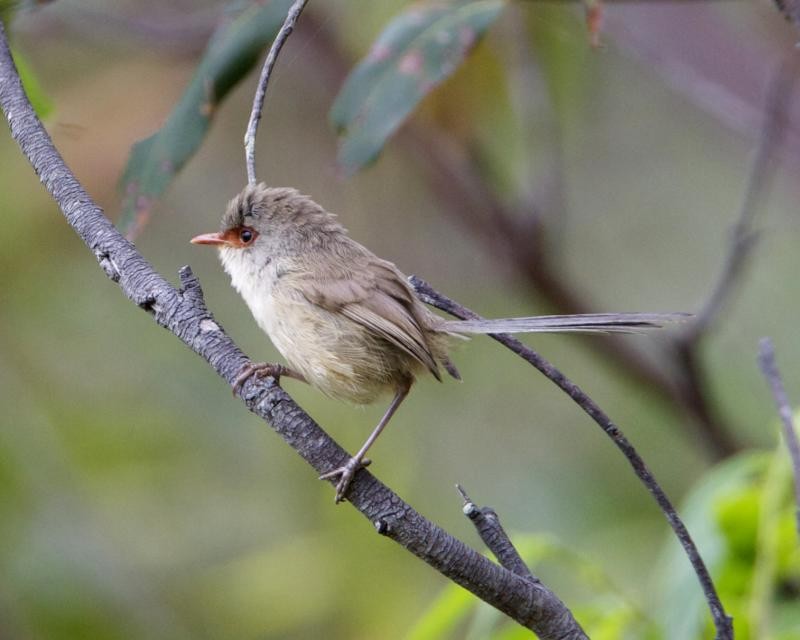Variegated Fairywren
A species of Fairywrens Scientific name : Malurus lamberti Genus : Fairywrens
Variegated Fairywren, A species of Fairywrens
Botanical name: Malurus lamberti
Genus: Fairywrens
Content
Description General Info
 Photo By Lip Kee Yap , used under CC-BY-SA-2.0 /Cropped and compressed from original
Photo By Lip Kee Yap , used under CC-BY-SA-2.0 /Cropped and compressed from original Description
The variegated fairywren is 14–15 cm (5.5–6 in) long and weighs 6–11 g (0.21–0.39 oz). Like other fairywrens, it is notable for its marked sexual dimorphism, males adopting a highly visible breeding plumage of brilliant iridescent blue and chestnut contrasting with black and grey-brown. The brightly coloured crown and ear tufts are prominently featured in breeding displays. The male in breeding plumage has striking bright blue ear coverts, with the crown often slightly darker, a black throat and nape, a royal blue upper back, chestnut shoulders and a bluish-grey tail. The wings are grey-brown and the belly creamy white. Non-breeding males, females and juveniles are predominantly grey-brown in colour; all males have a black bill and lores (eye-ring and bare skin between eyes and bill), while females have a red-brown bill and bright rufous lores. Immature males will develop black bills by six months of age, and moult into breeding plumage the first breeding season after hatching, though this may be incomplete with residual brownish plumage and may take another year or two to perfect. Both sexes moult in autumn after breeding, with males assuming an eclipse non-breeding plumage. They will moult again into nuptial plumage in winter or spring. The blue coloured plumage, particularly the ear-coverts, of the breeding males is highly iridescent due to the flattened and twisted surface of the barbules. The blue plumage also reflects ultraviolet light strongly, and so may be even more prominent to other fairywrens, whose colour vision extends into that part of the spectrum. 
Size
15 cm
Nest Placement
Shrub
Feeding Habits
Variegated Fairywren primarily eat insects like ants, grasshoppers, and larvae, foraging in shrubby vegetation under 2 m high.
Habitat
The variegated Fairywren is typically found in a range of dense shrubby vegetation environments, including coastal scrub, thickets in rocky terrains, and areas along creeks, extending to dry, arid interior regions. Broader geographic areas include scrublands with sufficient cover, often utilizing mammal burrows for shelter in extreme heat. While variegated Fairywren can be spotted in urban settings like suburbs, they show a preference for regions with high plant diversity, rather than merely dense cover. Notably, they are not well adapted to forestry plantations, such as pine and eucalypt, due to the lack of underbrush.
Dite type
Insectivorous
General Info
Feeding Habits
Bird food type
Behavior
Like all fairywrens, the variegated fairywren is an active and restless feeder, particularly on open ground near shelter, but also through the lower foliage. Movement is a series of jaunty hops and bounces, its balance assisted by a relatively large tail, which is usually held upright, and rarely still. The short, rounded wings provide good initial lift and are useful for short flights, though not for extended jaunts. During spring and summer, birds are active in bursts through the day and accompany their foraging with song. Insects are numerous and easy to catch, which allows the birds to rest between forays. The group often shelters and rests together during the heat of the day. Food is harder to find during winter and they are required to spend the day foraging continuously. Like other fairywrens, male variegated fairywrens have been observed carrying brightly coloured petals to display to females as part of a courtship ritual. In this species, the petals that have been recorded have been yellow. Petals are displayed and presented to a female in the male fairywren's own or another territory. The variegated fairywren is a cooperative breeding species, with pairs or small groups of birds maintaining and defending small territories year-round. Though less studied than the superb- and splendid fairywrens, it is presumably socially monogamous and sexually promiscuous, with each partner mating with other individuals. Females and males feed young equally, while helper birds assist in defending the territory and feeding and rearing the young. Birds in a group roost side-by-side in dense cover as well as engage in mutual preening. Occasionally larger groups of around 10 birds have been recorded, though it is unclear whether this was incidental or a defined flock. 
Distribution Area
The variegated fairywren is found in scrubland with plenty of vegetation providing dense cover. They have been reported to shelter in mammal burrows to avoid extreme heat. In urban situations such as suburban Sydney, these fairywrens have been said to prefer areas with more cover than the related superb fairywren, though a 2007 survey in Sydney's northern suburbs has proposed that variegated fairywrens may prefer areas of higher plant diversity rather than denser cover as such. Forestry plantations of pine and eucalypts are generally unsuitable as they lack undergrowth. 
Species Status
Not globally threatened.
Scientific Classification
Phylum
Chordates Class
Birds Order
Perching birds Family
Australasian wrens Genus
Fairywrens Species
Variegated Fairywren